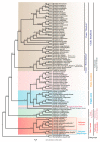Ten Plastomes of Crassula (Crassulaceae) and Phylogenetic Implications
- PMID: 36552287
- PMCID: PMC9775174
- DOI: 10.3390/biology11121779
Ten Plastomes of Crassula (Crassulaceae) and Phylogenetic Implications
Abstract
The genus Crassula is the second-largest genus in the family Crassulaceae, with about 200 species. As an acknowledged super-barcode, plastomes have been extensively utilized for plant evolutionary studies. Here, we first report 10 new plastomes of Crassula. We further focused on the structural characterizations, codon usage, aversion patterns, and evolutionary rates of plastomes. The IR junction patterns-IRb had 110 bp expansion to rps19-were conservative among Crassula species. Interestingly, we found the codon usage patterns of matK gene in Crassula species are unique among Crassulaceae species with elevated ENC values. Furthermore, subgenus Crassula species have specific GC-biases in the matK gene. In addition, the codon aversion motifs from matK, pafI, and rpl22 contained phylogenetic implications within Crassula. The evolutionary rates analyses indicated all plastid genes of Crassulaceae were under the purifying selection. Among plastid genes, ycf1 and ycf2 were the most rapidly evolving genes, whereas psaC was the most conserved gene. Additionally, our phylogenetic analyses strongly supported that Crassula is sister to all other Crassulaceae species. Our findings will be useful for further evolutionary studies within the Crassula and Crassulaceae.
Keywords: Crassula; Crassulaceae; DNA barcoding; codon aversion; codon usage; evolutionary rates; phylogeny; plastome.
Conflict of interest statement
The authors declare no conflict of interest.
Figures










Similar articles
-
Intraspecific and Intrageneric Genomic Variation across Three Sedum Species (Crassulaceae): A Plastomic Perspective.Genes (Basel). 2024 Mar 31;15(4):444. doi: 10.3390/genes15040444. Genes (Basel). 2024. PMID: 38674379 Free PMC article.
-
Plastome evolution of Aeonium and Monanthes (Crassulaceae): insights into the variation of plastomic tRNAs, and the patterns of codon usage and aversion.Planta. 2022 Jul 9;256(2):35. doi: 10.1007/s00425-022-03950-y. Planta. 2022. PMID: 35809200
-
A new perspective on codon usage, selective pressure, and phylogenetic implications of the plastomes in the Telephium clade (Crassulaceae).Gene. 2024 Jan 20;892:147871. doi: 10.1016/j.gene.2023.147871. Epub 2023 Oct 4. Gene. 2024. PMID: 37797779
-
Phylogenomics and plastomics offer new evolutionary perspectives on Kalanchoideae (Crassulaceae).Ann Bot. 2024 Apr 23;133(4):585-604. doi: 10.1093/aob/mcae017. Ann Bot. 2024. PMID: 38359907 Free PMC article.
-
Dynamic evolution of the plastome in the Elm family (Ulmaceae).Planta. 2022 Dec 17;257(1):14. doi: 10.1007/s00425-022-04045-4. Planta. 2022. PMID: 36526857 Review.
Cited by
-
Exploring Plastomic Resources in Sempervivum (Crassulaceae): Implications for Phylogenetics.Genes (Basel). 2024 Mar 30;15(4):441. doi: 10.3390/genes15040441. Genes (Basel). 2024. PMID: 38674377 Free PMC article.
-
Intraspecific and Intrageneric Genomic Variation across Three Sedum Species (Crassulaceae): A Plastomic Perspective.Genes (Basel). 2024 Mar 31;15(4):444. doi: 10.3390/genes15040444. Genes (Basel). 2024. PMID: 38674379 Free PMC article.
-
Comparative Genomics Insights Into the Evolutionary Disparities Between Nitroplast-Evolved Ecotype UCYN-A2 and Its Closest Relative UCYN-A1.Ecol Evol. 2025 Jul 7;15(7):e71739. doi: 10.1002/ece3.71739. eCollection 2025 Jul. Ecol Evol. 2025. PMID: 40630086 Free PMC article.
-
Codon Usage Analyses Reveal the Evolutionary Patterns among Plastid Genes of Saxifragales at a Larger-Sampling Scale.Genes (Basel). 2023 Mar 11;14(3):694. doi: 10.3390/genes14030694. Genes (Basel). 2023. PMID: 36980966 Free PMC article.
-
Advances in Plant Taxonomy and Systematics.Biology (Basel). 2023 Apr 9;12(4):570. doi: 10.3390/biology12040570. Biology (Basel). 2023. PMID: 37106770 Free PMC article.
References
-
- Thiede J., Eggli U. Crassulaceae. In: Kubitzki K., editor. The Families and Genera of Vascular Plants. Springer; Berlin/Heidelberg, Germany: 2007. pp. 83–118.
-
- Smith G.F., Figueiredo E., Van Wyk A.E. Kalanchoe (Crassulaceae) in Southern Africa: Classification, Biology, and Cultivation. Academic Press; London, UK: 2019.
-
- Messerschmid T.F., Klein J.T., Kadereit G., Kadereit J.W. Linnaeus’s folly–phylogeny, evolution and classification of Sedum (Crassulaceae) and Crassulaceae subfamily Sempervivoideae. Taxon. 2020;69:892–926. doi: 10.1002/tax.12316. - DOI
-
- Mort M., O’Leary T., Carrillo-Reyes P., Nowell T., Archibald J., Randle C. Phylogeny and evolution of Crassulaceae: Past, present, and future. Schumannia. 2010;6:69–86.
Grants and funding
- NEL&MARA-003/the Opening Foundation of National Engineering Laboratory of Soil Pollution Control and Remediation Technologies, and Key Laboratory of Heavy Metal Pollution Prevention & Control, Ministry of Agriculture and Rural Affairs
- BK20211078/the Basic Research Program (Natural Science Foundation) of Jiangsu Province
- YJS20210136/the Scientific Research Project Foundation of Postgraduate of the Anhui Higher Education Institutions of China
LinkOut - more resources
Full Text Sources
Research Materials
Miscellaneous

